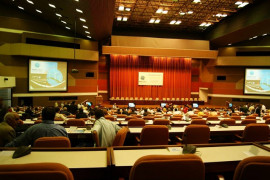
Therefore, while economic growth is a crucial tool for development strategies, these strategies must more deliberately target economic, social and environmental dimensions, according to the OECD Development Centre’s Perspectives on Global Development 2019 launched on Thursday (Nov 29, 2018) at the 6th OECD World Forum on Statistics, Knowledge and Policy in Incheon, Korea.
The report concludes that development strategies must do more to embrace the multidimensionality of development, acknowledging the fact that growth does not automatically yield improvements in well-being.
The time is said to be ripe for change. Since the 1990s, large developing countries have continuously re-drawn the map of global economic relations in terms of trade, finance and migration, challenging longstanding notions of development.
This major transformation has been buoyed by large emerging economies such as China, India, Indonesia, Russia and Brazil, growing faster than the OECD average and creating a ripple effect on other developing countries.
Over the 2011-16 period China and India’s contribution to global growth reached 29% and 11%, respectively.

Developing economies are, therefore, being asked to find innovative solutions in the face of challenges that did not exist for previously industrialising countries. For example, despite efforts to focus on social inclusiveness and environmental sustainability, few national development plans today are responding to the emergence of new global rules, increasing interdependence among countries, unprecedented population booms, and the high mobility of people or fast technological change.
Globally, well‑being indicators have been closely correlated with GDP per capita. However, the relationship between well‑being and GDP per capita has changed over time. Two periods can be identified:
- From 1820 until 1870, countries with higher GDP per capita did not always report better well‑being outcomes.
- After 1870 the correlation between GDP per capita and well‑being measures became stronger, due to cheaper American food imports in Europe boosting real wages, the rise of democratic regimes, breakthroughs in medical knowledge and social policy measures.
During the early years of industrialisation, between the 1820s and 1870s, the rate of GDP growth for industrialised countries was around 1‑1.5% per annum. Although relatively slow, GDP growth was underway, but had almost no positive impact on well‑being. This ‘early growth paradox’ was the price that early industrialisers paid for rapid urbanisation and proletarisation.
Since the 1950s, countries which began to grow rapidly have been distinguished from early developers by the phenomenon of ‘catching up’ or GDP per capita convergence. In Asia, spectacular economic growth has been accompanied by remarkable gains in certain dimensions of well‑being (life expectancy, education), but not all.
Beyond goals of economic growth, most national development plans being designed today are said to focus on social inclusiveness and environmental sustainability. However, few show awareness of mega trends and the challenges and opportunities they present. Some challenges have been faced before: the potential slowdown of global growth, trade protectionism, the rise in inequality, population growth and weakening global governance.
However, new challenges have emerged that early industrialising countries did not face. These include new global rules, interdependence between countries, unprecedented population booms, high mobility, risk of pandemics and climate change. They also include new technologies, spanning digitisation, automation, artificial intelligence and biotechnology.
Therefore emerging economies, including countries like Pakistan, need to take and will take different development paths than early industrialisers.
Indeed, in the wake of shifting wealth, new strategies include greater South‑South co-operation, policies linking migration and development, and novel ways to extend social protection.
Experience suggests that strategies are a useful tool to ensure balanced growth, inclusive of social and environmental matters. Rather than forging a singular development paradigm for all countries, history is said to teach us that development strategies are most effective when they are multi-sectoral, participatory, location‑specific and embedded in multilateralism, and when the necessary resources and political will are available to ensure implementation.
Novel ways of promoting development are emerging, however, outside of the toolbox set out in the aftermath of the Second World War.
Published in The Express Tribune, December 1st, 2018.
Like Opinion & Editorial on Facebook, follow @ETOpEd on Twitter to receive all updates on all our daily pieces.


















1714027629-0/Ranbirtransformation-(1)1714027629-0-270x192.webp)

























COMMENTS
Comments are moderated and generally will be posted if they are on-topic and not abusive.
For more information, please see our Comments FAQ